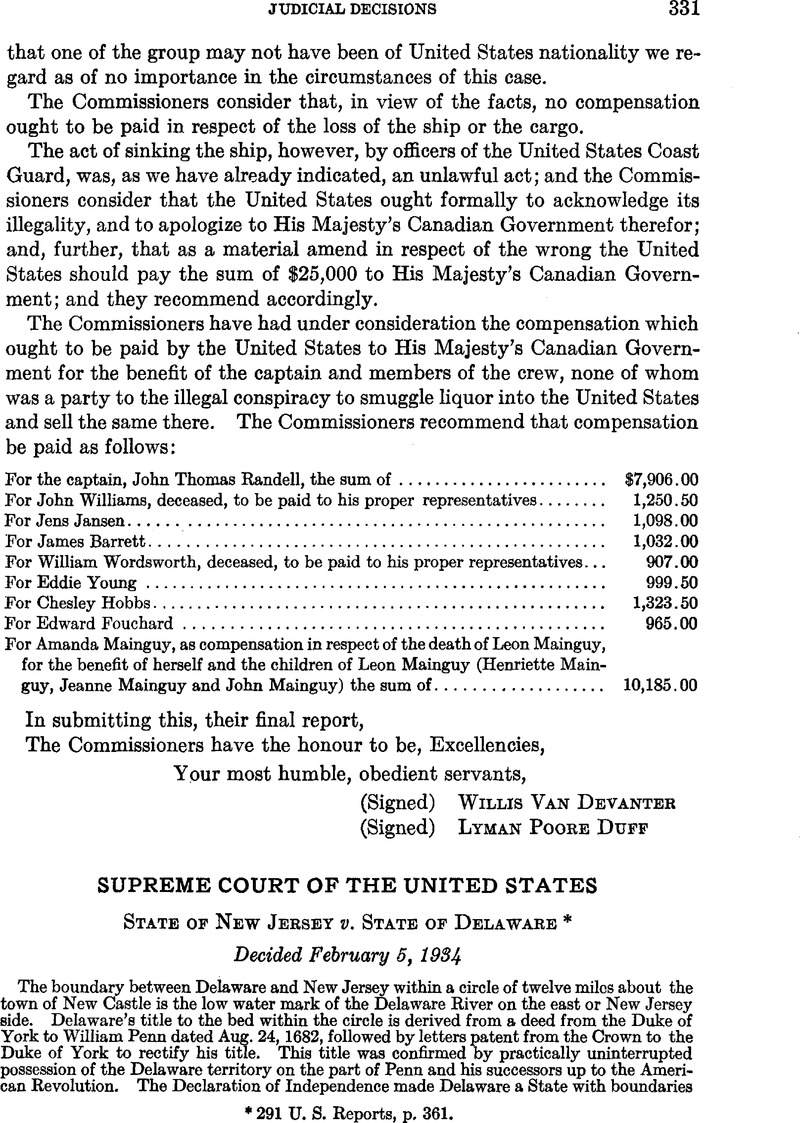No CrossRef data available.
Article contents
Court State of New Jersey v. State of Delaware*
Published online by Cambridge University Press: 12 April 2017
Abstract

- Type
- Judicial Decisions Involving Questions of International Law
- Information
- Copyright
- Copyright © American Society of International Law 1935
Footnotes
291 U. S. Reports, p. 361.
References
1 The following is the description: “All that the Towne of Newcastle otherwise called Delaware and the fort therein or thereunto belonging scituate lying and being between Maryland and New Jersey in America And all that Tract of land lying within the Compasse or Circle of twelve miles about the said Towne Scituate lying and being upon the River of Delaware and all Islands in the said River of Delaware and the said River and Soyle thereof lying North of the Southermost part of the said Circle of twelve miles about the said Towne And all that Tract of Land upon Delaware River and Bay beginning twelve miles South from the said Towne of Newcastle otherwise called Delaware and extending South to Cape Lopen.” Powers of government and other proprietary and seignorial rights were granted to the Duke along with ownership of the fee.
2 Compare, however, as to covenants of seisin, Doane v. Willcut, 5 Gray 328; Allen v. Sayward, 5 Me. 446.
3 The Attorney General filed two answers in the cause, neither of which asserted any beneficial title in the Crown, but merely prayed that the court might “Preserve all such Rights Title and Interest of in or to the Premises as shall appertain or belong to his Majesty.“
4 The complainant points for illustration to the construction of important works for the use of the Dupont Co. 4,400 feet below low water level, and taxation of these works like other property in New Jersey. At that time controversy was flagrant between the two states. No inference of ownership can be drawn from dominion exerted in such conditions.
5 Grotius has this to say (De Jure Belli ac Pacts, Book 2, c. 3, § 18): “In Case of any Doubt, the Jurisdictions on each Side reach to the Middle of the River that runs betwixt them, yet it may be, and in some Places it has actually happened, that the River wholly belongs to one Party; either because the other Nation had not got possession of the other Bank, ‘till later, and when their Neighbours were already in Possession of the whole River, or else because Matters were stipulated by some Treaty.“ In an earlier section (§ 16, subdivision 2) he quotes a statement of Tacitus that at a certain point “the Rhine began … to have a fixed Channel, which was proper to serve for a Boundary. ” Vattel (taw of Nations, supra) states the rule as follows: “If, of two nations inhabiting the opposite banks of the river, neither party can prove that they themselves, or those whose rights they inherit, were the first settlers in those tracts, it is to be supposed that both nations came there at the same time, since neither of them can give any reason for claiming thepreference; and in this case the dominion of each will extend to the middle of the river.“
6 See also the treaties collected in the Argument of the United States before the International Boundary Commission in the Chamizal Arbitration of 1910 between the United States and Mexico. Nys traces the concept of the Thalweg to a period earlier than the Treaty of Munster, 1648. Droit International, v. 1, p. 426.
7 “International law, as well as domestic law, may not contain, and generally does not contain, express rules decisive of particular cases; but the function of jurisprudence is to resolve the conflict of opposing rights and interests by applying, in default of any specific provision of law, the corollaries of general principles… . This is the method of jurisprudence; it is the method by which law has been gradually evolved in every country resulting in the definition and settlement of legal relations as well between States as between private individuals.” The case of the Eastern Extension Australasia and China Telegraph Co., Ltd., decided November 9, 1923, by the British American Arbitral Tribunal under the Convention of August 18, 1910, Nielsen's Report, pp. 75, 76, quoted by Lauterpacht, supra, p. 110.


